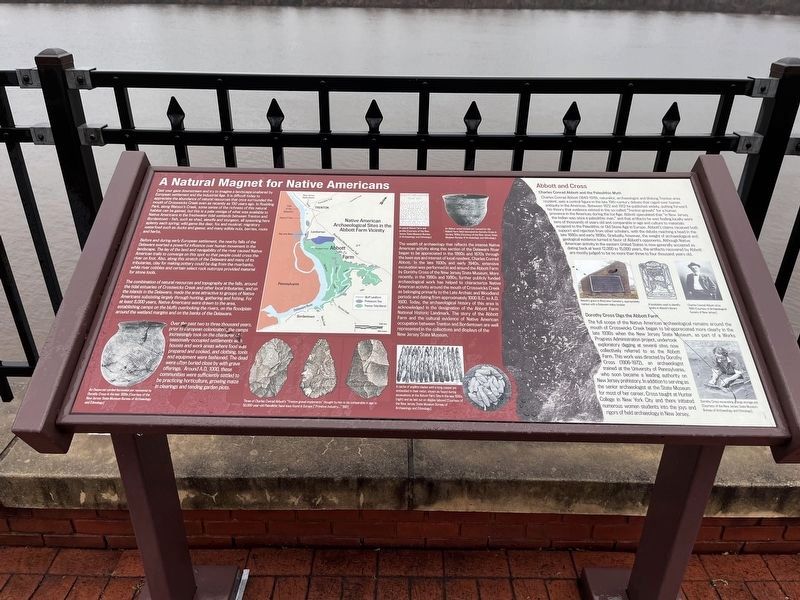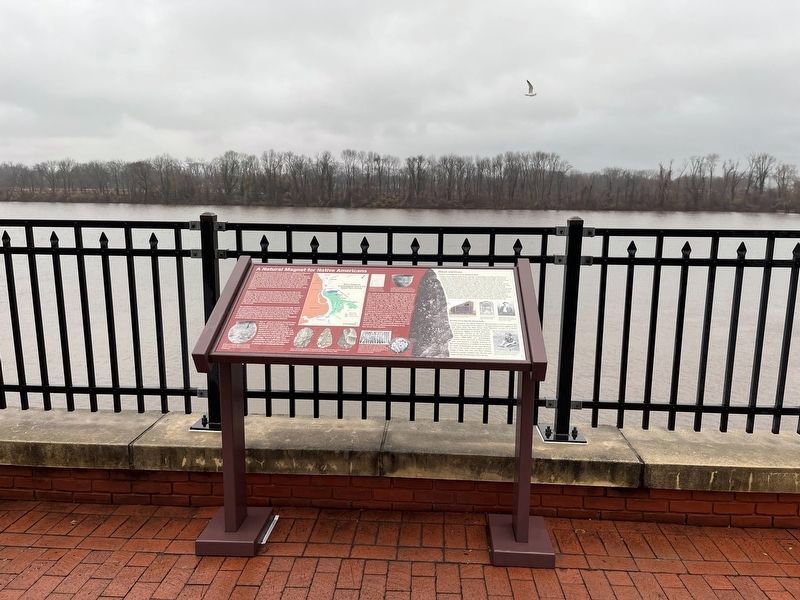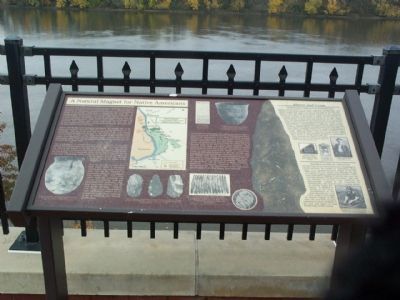South Trenton in Mercer County, New Jersey — The American Northeast (Mid-Atlantic)
A Natural Magnet for Native Americans

Photographed By Devry Becker Jones (CC0), December 16, 2022
1. A Natural Magnet for Native Americans Marker
Cast your gaze downstream and try to imagine a landscape unaltered by European settlement and the Industrial Age. It is difficult today to appreciate the abundance of natural resources that once surrounded the mouth of Crosswicks Creek even as recently as 150 years ago. In Roebling Park, along Watson’s Creek, some sense of the richness of this natural habitat can be gained, but this is a pale vestige of what was available to Native Americans in the freshwater tidal wetlands between Trenton and Bordentown—fish, such as shad, alewife and sturgeon, all spawning here aplenty each spring; wild game like deer, fox and muskrat; migratory waterfowl such as ducks and geese; and many edible nuts, berries, roots and herbs.
Before and during early European settlement, the nearby falls of the Delaware exerted a powerful influence over human movement in the landscape. The lay of the land and navigability of the river caused Native American trails to converge on this spot so that people could cross the river on foot. Also, along this stretch of the Delaware and many of its tributaries, clay for making pottery could be dub from the riverbanks, while river cobbles and certain select outcrops provided material for stone tools.
The combination of natural resources and topography at the falls, around the tidal estuaries of Crosswicks Creek and other local tributaries, and on the islands in the Delaware made this area attractive to groups of Native Americans subsisting largely through hunting, gathering and fishing. For at least 8,000 years, Native Americans were drawn to the area, establishing camps on the bluffs overlooking the rivers, on the floodplain around the wetland margins and on the banks of the Delaware.
Over the past two to three thousand years, prior to European colonization, the camps increasingly took on the character of seasonally-occupied settlements with houses and work areas where food was prepared and cooked, and clothing, tools and equipment were fashioned. The dead were often buried close by with grave offerings. Around A.D. 1000, these communities were sufficiently settled to be practicing horticulture, growing maize in clearings and tending garden plots.
The wealth of archaeology that reflects the intense Native American Activity along this section of the Delaware River began to be appreciated in the 1860s and 1870s through the keen eye and interest of local resident, Charles Conrad Abbott. In the late 1930s and early 1940s, extensive excavation was performed in and around the Abbott Farm by Dorothy Cross of the New Jersey State Museum. More recently, in the 1980s and 1990s, further publicly funded archaelogical work has helped to characterize Native
American activity around the mouth of Crosswicks Creek as belonging primarily to the Late Archaic and Woodland periods and dating from approximately 1000 B.C. to A.D. 1600. Today, the archaeological history of this area is acknowledged in the designation of the Abbott Farm National Historic Landmark. The story of Abbott Farm and the cultural evidence of Native American occupation between Trenton and Bordentown are well represented in the collections and displays of the New Jersey State Museum.
Abbott and Cross
Charles Conrad Abbott and the Paleolithic Myth. Charles Conrad Abbott (1843–1919), naturalist, archaeologist and lifelong Trenton area resident, was a central figure in the late 19th-century debate that raged over human antiquity in the Americas. Between 1872 and 1912 he published widely, putting forward his theory that evidence existed in the so-called “Trenton gravels” for a human presence in the Americas during the Ice Age. Abbott speculated that “in New Jersey the Indian was once a Paleolithic man,” and that artifacts he was finding locally were tens of thousands of years old and comparable in age and culture to materials assigned to the Paleolithic or Old Stone Age in Europe. Abbott’s claims received both support and rejection from other scholars, with the debate reaching a head in the late 1880s and

Photographed By Devry Becker Jones (CC0), December 16, 2022
3. A Natural Magnet for Native Americans Marker
Dorothy Cross Digs the Abbott Farm. The full scope of the Native American archaeological remains around the mouth of Crosswicks Creek began to be appreciated more clearly in the late 1930s when the New Jersey State Museum, as part of a Works Progress Administration project, undertook exploratory digging at several sites now collectively referred to as the Abbott Farm. This work was directed by Dorothy Cross (1906-72), an archaeologist trained at the University of Pennsylvania, who soon became a leading authority on New Jersey pre-history. In addition to serving as the senior archaeologist at the State Museum for most of her career, Cross taught at Hunter College in New York City and there initiated numerous women students to the joys and rigors of field archaeology in New Jersey.
Erected 2004 by New Jersey Department of Transportation.
Topics and series. This historical marker is listed in these topic lists: Anthropology & Archaeology • Native Americans. In addition, it is included in the National Historic Landmarks, and the Works Progress Administration (WPA) projects series lists.
Location. 40° 11.748′ N, 74° 45.458′ W. Marker is in Trenton, New Jersey, in Mercer County. It is in South Trenton. Marker can be reached from New Jersey Route 29. This marker is in South River Walk park which is built over top of Route 29. Touch for map. Marker is in this post office area: Trenton NJ 08611, United States of America. Touch for directions.
Other nearby markers. At least 8 other markers are within walking distance of this marker. Riverview Cemetery (within shouting distance of this marker); Shipping on the Delaware (within shouting distance of this marker); Ferries across the Delaware (about 400 feet away, measured in a direct line); South Riverwalk Park (about 700 feet away); Ice, Brewing and Bottles (approx. 0.2 miles away); c. 10,000 – 12,000 Years Ago (approx. 0.2 miles away); Paleo-Indians (approx. 0.2 miles away); a different marker also named Paleo-Indians (approx. 0.2 miles away). Touch for a list and map of all markers in Trenton.
More about this marker. The marker is in the southern half of the park overlooking the Delaware River.
Credits. This page was last revised on February 16, 2023. It was originally submitted on December 26, 2007, by Gary Nigh of Trenton, New Jersey. This page has been viewed 2,254 times since then and 35 times this year. Last updated on February 2, 2021, by Carl Gordon Moore Jr. of North East, Maryland. Photos: 1. submitted on December 18, 2022, by Devry Becker Jones of Washington, District of Columbia. 2. submitted on December 26, 2007, by Gary Nigh of Trenton, New Jersey. 3. submitted on December 18, 2022, by Devry Becker Jones of Washington, District of Columbia. • Devry Becker Jones was the editor who published this page.
